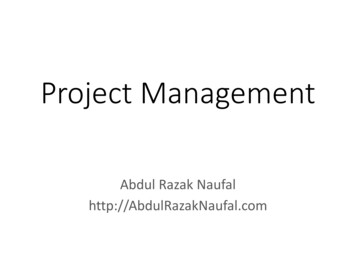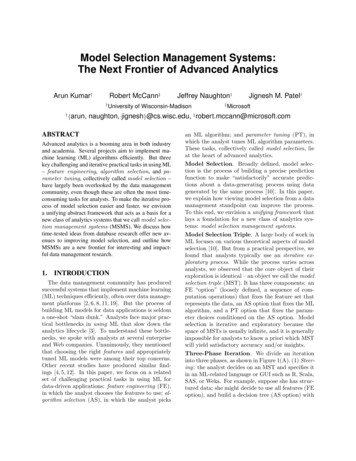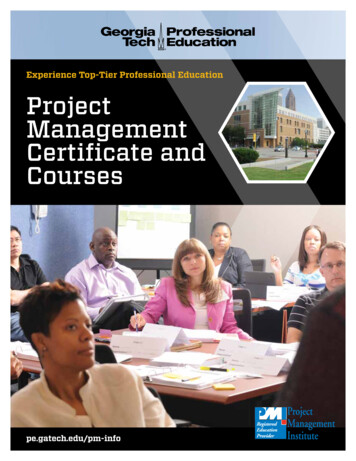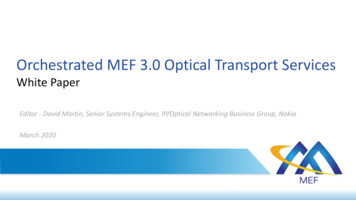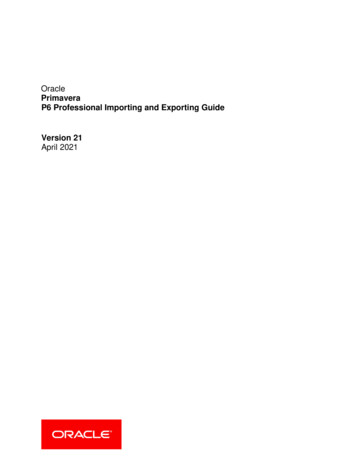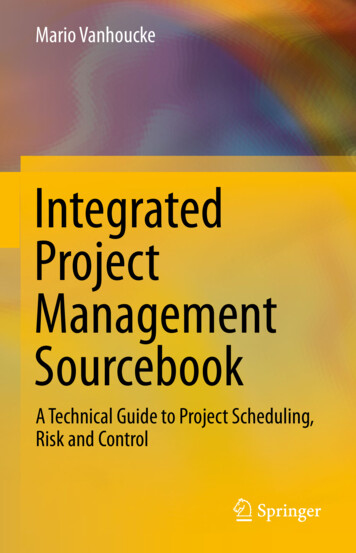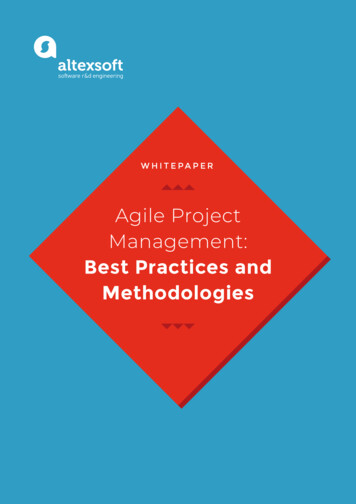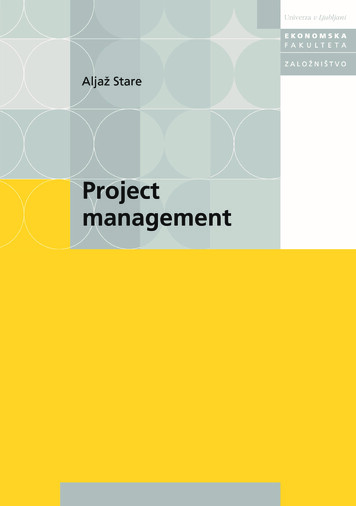
Transcription
Aljaž StareProject managementCourse textbookUniversity of Ljubljana FACULTY OF ECONOMICSPublishing
Faculty of Economics University of LjubljanaAljaž StareProject management, Course bookPublisher:For publisher:Faculty of Economics, LjubljanaDean, prof. dr. Metka TekavčičEditorial board:prof. dr. Mojca Marc (predsednica), doc. dr. Mateja Bodlaj,lekt. dr. Nadja Dobnik, prof. dr. Marko Košak,prof. dr. Tanja Mihalič,prof. dr. Aleš Popovič,prof. dr. Tjaša RedekReviewer:doc. dr. Darija AleksićCover page designed by:Design and layout:Robert IlovarNina KotarTextbook is availabe online: http://www.ef.uni-lj.si/zaloznistvo/studijska gradivaLjubljana, 2019Kataložni zapis o publikaciji (CIP) pripravili v Narodni in univerzitetni knjižnici v LjubljaniCOBISS.SI-ID 299423232ISBN 978-961-240-351-5 (pdf)All rights reserved. No part of this publication may be reproduced or transmitted in any form by anymeans, electronic, mechanical or otherwise, including (but not limited to) photocopy, recordings orany information or retrieval system, without the express written permission of the author or copyrightholder.
CONTENTS1PROJECT – WHAT AND WHEN 1.11.21.31.42CHARACTERISTICS AND TYPES OF PROJECTS PROJECT LIFE CYCLE AND PROJECT PHASES PROJECT STAKEHOLDERS DISCUSSION QUESTIONS PROJECT MANAGEMENT 2.12.22.32.43110PROJECT MANAGEMENT PROCESS PROJECT MANAGEMENT KNOWLEDGE AREAS PROJECT MANAGER DISCUSSION QUESTIONS PROJECT INITIATION (CONCEPTION) 3.13.23.33.43.53.6DEFINITION AND PROCESS PROJECT PROPOSAL FEASIBILITY STUDY DELIVERABLE(S) SPECIFICATIONS PROJECT CHARTER DISCUSSION QUESTIONS 562428303338393941DEFINITION OF ORGANISATION TYPICAL PROJECT ORGANISATION STRUCTURES PROJECT STAKEHOLDERS ORGANISATION/RELATIONS – OBS/RBS MATRIX OF AUTHORITY AND RESPONSIBILITIES (RAM/RAC) TEAM RULES DISCUSSION QUESTIONS PROJECT TEAM LEADERSHIP 6.16.26.36.46.56.61724PROJECT SCHEDULING RESOURCE PLANNING COST PLANNING PROJECT RISK MANAGEMENT PROCUREMENT PLAN INFORMATION AND DOCUMENTATION MANAGEMENT PLAN DISCUSSION QUESTIONS PROJECT ORGANISATION 5.15.25.35.45.55.6101213161719192222234 PROJECT PLANNING 4.14.24.34.44.54.64.7157941424950515253TEAM LEADERSHIP FACTORS TEAMWORK DIFFERENT LEADERSHIP STYLES MOTIVATING TEAM MEMBERS COMMUNICATION ON THE PROJECT TEAM DISCUSSION QUESTIONS iii535357586162
7PROJECT CONTROL 7.17.27.37.47.57.67.77.8863EFFECTIVE AND INTEGRATED CONTROL PROJECT TRACKING/MONITORING SCHEDULE CONTROL COST CONTROL – EVA/EVM QUALITY CONTROL RISK CONTROL REPORTING TO SUPERIORS ON THE PROGRESS OF THE PROJECT DISCUSSION QUESTIONS PROJECT CLOSURE 728.1 COMPLETION OF WORK 8.2 ADMINISTRATIVE CLOSURE 8.3 DISCUSSION QUESTIONS 96364656768697071727375ACRONYMS 76REFERENCES 78iv
TABLE OF FIGURESFigure 1: Typical projects Figure 2: Project goal and objectives Figure 3: Project life cycle / phases Figure 4: Project stakeholders Figure 5: Project management process Figure 6: Project management knowledge areas Figure 7: Project management competencies Figure 8: Important project management personal qualities Figure 9: Project initiation Figure 10: WBS, developed from PBS Figure 11: Activity network diagram Figure 12: Gantt chart Figure 13: Human resources plan in Gantt chart Figure 14: Cost plan Figure 15: Typical project risks and risk sources Figure 16: (Pure) project organisation Figure 17: Weak matrix organisation Figure 18: Strong matrix organisation Figure 19: Resource Breakdown Structure Figure 20: Real power of leader Figure 21: Motivation factors Figure 22: Team communication Figure 23: Project control process Figure 24: Project progress (time) control Figure 25: Project cost control (EVA) Figure 26: Regular project report Figure 27: Project closure Figure 28: Evaluation of the project execution Figure 29: Project final report 7375TABLE OF TABLESTabel 1: Typical project phases Tabel 2: WBS based on technology / phases of execution Tabel 3: Resource plan Tabel 4: Task based cost plan Tabel 5: Evaluated identified risks Tabel 6: Risk mitigation plan Tabel 7: Responsibility Assignment Matrix v6262931353751
PREFACEFrom the prehistory projects bring positive changes to our lives, yet project management professiongained value especially after the information revolution at the end of the 1970s. Verzuh states thatin the 1990s the project approach has developed from less useful industrial engineering disciplineto the main driver of US business, and Frame believes that project management has become thehottest managerial approach in this period. The first one considers the project management tobe the most effective toolbox of the 21st century, while last argue that flexibility is the guidingprinciple of the new world order, while project management is the key to flexibility. In the changingturbulent environment enterprises need to initiate even more changes than in the past in order tobe competitive, to avoid market treats and to utilise the potentials. Direction of change is set by thestrategy management while the project management toolkit enables the effective achievement ofstrategic goals.The objectives of this book are to assure an awareness of the importance of project managementin modern business environment, to understand the role of the project manager, to develop thecapacity to assess business opportunities, to get familiarity with the project management toolkit,and to develop the capacity for teamwork and leading the team and individuals. This book guidesstudents through fundamental project management concepts and behavioural skills needed tosuccessfully initiate, plan, implement and close a project.The book presents and explains project management methods, tools and techniques in orderto learn how to manage project time, costs, quality, resources, risks and delivery. The gainedknowledge will enable the development of skills for successful project scope definition andstakeholder analysis, appropriate selection of the project implementation strategy, assessingand planning the schedule, resources, costs, selection of appropriate project organization, andcontrolling the project.Familiarity with the topics of the book will enable students to independently manage less complexprojects or to lead project sub-teams under a mentorship of experienced project manager in anefficient manner, regardless of the type of project: product development, process reengineering,house construction, company takeover, or event organisation.vi
1PROJECT – WHAT AND WHENIn order to define the term more precisely, we quote some definitions from the world's leadingproject management experts. A project is:›› a unique task designed to attain a specific result that requires a variety of resources and islimited in time (Andersen et al., 2009)›› a goal-oriented process that involves the coordinated undertaking of interrelated activities(Frame, 2003)›› any series of activities and tasks that have a specific objective to be completed withincertain specifications, have defined start and end dates, have funding limits (if applicable),consume human and nonhuman resources, and is multifunctional (Kerzner, 2009)›› a collection of linked activities carried out in an organised manner with a clearly definedstart point and finish point to achieve some specific results that satisfy the needs of anorganization as derived from the organization’s current business plans (Young, 2007)›› sequence of unique, complex and connected activities that have one goal and purposethat must be completed by a specific time, within budget, and according to specification(Wysocki, 2009)definitionA project is a unique, time- and cost-limited, complex targeted process of logically related tasks thatmust be accomplished in order to create products or services in accordance with quality standards andcustomer requirements.1.1 CHARACTERISTICS AND TYPES OF PROJECTS1.1.1 Typical project characteristicsTypical project characteristics include finality, uniqueness, goal orientation, complexity,integration of project tasks and conflictness. The following is a summarized definition of thesecharacteristics by various authors (Burke, 2003; Frame, 2003; Meredith and Mantel, 2009;PMBOK, 2008). Most of those features are already included in the definition of the project:Temporariness or finality – the project is not a process, which would be implementedpermanently, but is limited in time and has a clearly defined and agreed time limit, including startand end date. The finality does not apply to products of the project.1
Uniqueness – projects create unique products, services or results. The project is unique, becauseit is unlikely to be repeated in the same manner and with the same participants. Project executioncannot be a standard routine; however, each project contains routine tasks.Goal orientation – a project is organised to achieve one or more objectives (product, service,etc.), so all project tasks are planned and implemented to achieve the set objectives.Limited - the project is limited by constraints such as quality, deadline and budget (usually calledtriple constraint). Gilb (1997) further notes legal, ethical, community health and social aspects.Some authors note the constraint of enterprise personal. However, the real constraint is the budgetof the project — if it is high enough, project manager can hire the best experts in the world.Complexity – a project may have a very complex goals, which require a lot of interrelatedtasks, and a wide mix of people with different skills, roles and responsibilities. The complexityof the project requires careful coordination and control of time, cost and performance. It is alsoimportant to harmonise the project schedule and execution with other projects in the enterprise.Connected and interdependent project tasks – a project consists of a series of related tasksto be carried out in order to deliver the required deliverable(s). Tasks are mutually dependent,because some cannot be implemented before the previous one. Implementation of the project alsodepends on the implementation of the tasks of other projects in the enterprise, but often there isinterference with the project due to day-by-day work in the enterprise.Conflict - project managers work in a much more conflicted environment than other managers.The project is an organisation within the organisation, and project managers compete withline (function) managers for people and other resources, which is especially marked in a multiproject environment. Individuals have two superiors (project and functional), who have differentobjectives and priorities. Conflict can also be seen in the conflict of interest of the projectstakeholders (client, enterprise, project team and the public).Riskiness is related to uniqueness and conflict. Since each project is different from the previousone, there is a risk that the team will be surprised by many problems during the project, such asdifficulties in implementation, change requirements by the client, weather, influential individuals,etc. All of this may hinder performance and prevent project completion within expectations.2
1.1.2 Typical types of projectsThere are different criteria used to divide projects into different types regardless of the content,specificity of objectives, duration, intensity, repeatability of content. Projects can be divided intothree main groups:›› investment projects›› research and development projects›› organisational projectsInvestment projects are usually subdivided according to two typical groups of stakeholders- investors and contractors. The investor (and payer) will use project deliverable (building,production line, SW) for longer time and have long-term benefits, while the contractor willdeliver a deliverable and receive the one-time payment. In this case, we are talking about business(usually engineering) projects (Fig 1).Figure 1: Typical projectsJust like the term organisation has several meanings (enterprise, structure, organisation of work),there are different types of organisational projects: (re)organisation of enterprises (processreengineering, organisation structure change, introduction of new working methods, etc.) andthe organisation of events (culture , sports, conferences, etc.).The division of external and internal projects is also important. External projects have aknown payer, and projects are executed under a previously signed contract. External projects aregenerally business projects (engineering, construction, SW development), and they are typicallycarried out by project-oriented companies (projects are their day-by-day work). Internal projectsare implemented to strive for business results: competitive advantage, cost savings or increasedrevenues. Project deliverables provides long-term benefits. Typical internal projects are newproduct development, process reengineering, developing company website, investing in newproduction facilities, etc.3
1.1.3 Objective, goal, delivery, and scopeOxford Advanced Learner’s Dictionary defines goals and objectives as follows:›› goal – something that you hope to achieve, long term goals›› objective – something that you are trying to achieveProjects are generally executed in order to bring some benefits. This is the goal (or the purpose,which is rarely used) of the project. To understand the goal, we ask: Why do we want to execute thatproject? A goal is therefore an implicit target which is not carried out directly in the project but isrealised later as a consequence of the outcome of the project. Probability of goal achievement, dueto indirectness, is lower than the probability of attaining the objectives for which the project teamplans and carries out targeted tasks. The goal is also less precisely time-defined as an objective.Andersen states that the goal of the project is to solve a business problem, since the project is alwaysset up and executed in order to deliver products as a means to achieve business objectives. Thus, theproject goal is a business objective (Fig 2).Figure 2: Project goal and objectivesTo define the final outcome of the project, authors use two terms: objective and deliverable.According to Oxford Advanced Learner’s Dictionary, a deliverable is a product that a companypromises to have ready for a customer. The deliverable could also be defined as a result of the projecttasks (a product, a service, a new organization of work etc.). However, the terms objective anddeliverable are not synonymous but are logically connected. Expected deliverables are part of theproject objective, which is to create (develop, construct, establish) the deliverable(s) of appropriatequality, on time, and within budget.4
Deliverables and goals - some examplesThe new product (deliverable) will increase a market share (goal); SW will quicken a process and decreasecosts; a conference will be organised to promote the profession; a new production hall will expand theproduction of productsScope is the range of things that a subject, an organization, an task, etc. deals with (Oxford Dictionary).Wysocki (2009) states, that scope:›› defines the boundaries of the project and confirms the general understanding of the projectamong the participants›› is the basis for the definition of the objectives and the expected major products of the project,as agreed between the client and the contractor›› in the final phase (at delivery) is a utility to check whether the project is carried out inaccordance with the requirementsProject scope - an exampleThe scope of setting up a new manufacturing plant may include building construction, productionline establishment, modern warehouse equipping, employing people, design of logistics, and theplant opening. Part of those deliverables may be a part of the scope of another project (which will beimplemented concurrently or later) or will not be carried out at all (e.g. employment).1.2 PROJECT LIFE CYCLE AND PROJECT PHASESThere are two aspects of the life cycle. The first aspect shows a project through the function ofexpenditure for the implementation (money, input labour), while the other includes specificsubstantive phases. Regardless of the project type or included professions, every project has typicalphases; however, the nature and the duration of these phases depends on the type of project.Meredith and Mantel (2009) explain the progress of the project life cycle as follows. At thebeginning of the project, the project manager is selected; the project team is composed; necessaryresources are identified; and a list of tasks is drawn. At that time, the project is progressing slowlydue to many uncertainties, discussions, coordination, and decisionmaking. When the projectobjective is clearly defined, an execution plan is prepared, and resources defined; the projectrapidly progresses. Final project tasks are usually carried out slowly due to slower aggregation ofpartial results, complex final works, as well as quality control and correction of faults.Project phases cannot be equated with the process of management, although some authors’designation of phases is similar to the management steps (planning, organizing, leading andcontrolling). Phases are more substantive, each involving a product such as feasibility study,project plan, product, etc., resulting in a coherent set of tasks.5
Tabel 1: Typical project phasesBurke,CharvatCleland, Frame,DinsmoreLewisMeredith onceptConception,selectionFeasibility tEvaluation,terminationAnalysisMorris & Pinto,MilosevicPlanningDesignBuilt, nitoring,controllingTerminationClosingSources: Burke (2003), Charvat (2003), Cleland (2007), Dinsmore (2010), Frame (2003), Lewis (2007), Meredith inMantel (2009), Miloševic (2003), Thomsett (2002), Morris & Pinto (2007b), Wysocki (2009)As shown in Table 1, authors note different phases which do not differ much. We consider theproject phases proposed by Cleland, Frame and Dinsmore, and PMBOK (2008), yet the latter usedifferent naming of the first and last phases: initiating and closing (Fig 3).Initiation (conception) includes a definition of the idea (product, service), the problem that theproject will solve, or opportunity, which we will availed - the reasons why the project is needed(project purpose), and an estimation of the expected benefits (success criteria). The feasibility ofthe project (feasibility study) is considered. Finally, project scope and deliverable specifications aredefined along with the budget.Figure 3: Project life cycle / phasesThe planning phase follows. This is executed by the project manager and the core team, whichconsists of representatives of the professions involved in the project. They plan tasks, schedule,resources and costs, a contingency plan to deal with project risks, and the organization of theproject (relations, roles, responsibilities and authorities) and information system.Project execution includes implementation of the planned tasks by the schedule made in theprevious phase. This is the most extensive phase of the project, since it involves many people and6
most of the funds. For efficient execution, proper coordination of participants is critical alongwith leadership of team and control of performance.The last phase, project closure, contains the results delivery, documentation finalisation andfinal report writing. The project ends when the client accepts the deliverables; the project team isdisbanded; and the project manager produces the final report of the project.1.3 PROJECT STAKEHOLDERSThe project should meet the interests of different participants - project stakeholders (Fig 4):the client, users, project team, other involved persons from the enterprise where the project isimplemented, suppliers, lenders, subcontractors, shareholders, etc. Stakeholders are individualsor organizations that are actively involved in the project or whose interests may positively ornegatively affect the performance or completion of the project (PMBOK, 2008). Some authorsdivide stakeholders into active participants, key players that are part of the official projectorganisation and formally collaborate in project implementation, and project influencers,which may indirectly affect the achievement of project results with formal or hidden support oropposition.The definition of typical stakeholders of the project follows, taken from various sources (Kerzner,2009; PMBOK, 2008; Verzuh, 2008; Young, 2000). Note that one person can have multiple roles ina project (sales manager, for example, can be both, client and sponsor of the project).Figure 4: Project stakeholdersThe project manager is personally responsible for the effective implementation of the project(in time, budget, and quality), what ensures by appropriate planning, organising, leading andcontrolling of the team. Since this textbook deals with management of project, the role and tasksof the project manager will be explained in detail below.7
Top management (board, CEO) ensures that project goals and objectives are aligned with businessand strategic plans of the enterprise, determines the “fate” of the project (whether and when tostart and execute it, eventual interruption), allocates resources (money, people, equipment, etc.),defines projects’ priorities, supervises the project throughout the life cycle, and participates in theimportant decisions. The enterprise top manager may determine the supervising person on one’sbehalf; this may be a member of the management board, director of the project office (manager ofproject portfolio), or any of line managers.Especially in larger enterprises, where many projects are implementing concurrently, eachproject has a project sponsor, selected by top management. This is usually a more experiencedline/functional manager who ensures that the enterprise will have the greatest possible benefitfrom the project. Typical tasks include selection of project manager, validation of the projectplan, participation in important decisions, supervising team and project progress, resolvingdisagreements between stakeholders, and validation of any changes. In addition, sponsor’sinfluence and experience help the project manager to solve organisational problems in the project.The role of sponsor can also take a collective body, usually called a steering committee. In the caseof internal projects, members of the committee can be project sponsors, clients and line managerswhose subordinates are members of the project team. For external projects, particularly in theconstruction area where the project will have significant impact on the wider social environment,such committees may consist of representatives of the client, investors, local communities, etc.Responsibilities of the committee are similar to those of the sponsor; however, validation ofintermediate results at the project milestones and approval of changes that could significantlyincrease project costs or threaten the deadline are particularly important.The client/customer is the reason why the project exists. After completion of the project, theclient will achieve business goals by using project deliverables. The client defines the purposeand objectives of the project, clarifies the requirements, confirms the results at milestones, andconfirms the deliverables at the handover of the project. The client can be internal, from theenterprise where the project is implemented (department, process owner), or external.The project team consists of those who carry out tasks with necessary expertise. According to theliterature, there are three team levels:›› The core team consists of the closest collaborators of the project manager, usually keyexperts from professions included in the project. Members of the core team spent at least60% (usually 100%) of their working time on the project for the entire duration. They areusually selected before the project planning phase through the proposal of the sponsor,project manager or steering committee. Due to their expertise and experience, they play avery important role in the project planning (planning the implementation tactics, durationof tasks, the amount of work required, risks, etc.).8
›› The broader team is composed of the remaining performers of project tasks, working underthe direct leadership of members of the core team – key experts. Members of the broaderteam are determined during the project planning or project execution. The members of thebroader team do not have to participate throughout the entire project.›› The third level of project team are contractors.Line/functional managers (Young, 2000, calls them resource managers) allocate theirsubordinates to the project. Their responsibility is to ensure qualified and available professionalsfor the project. They are indirectly responsible for the effective work and the quality of the resultsof their subordinates. If necessary, they participate as expert advisers.If the enterprise that implements the project cannot provide total funds for the project, theproject (co)founders can also be important stakeholders. Especially in projects with wider socialsignificance, funders can be local communities or the government. Different coinvestors andsponsors can be invited to help with a loan, or an international (e.g. EU) or national grant may beobtained. Teams should be aware that co-founders want an influence in defining the objectivesand in the project execution; in addition, they require periodic reports on the implementation.According to Young (2000), the project also includes influential entities within or outside ofthe enterprise, called influencers. Internal influencers can be line managers, while externalinfluencers may be individuals or socio-political interest groups. Influencers are not a part of theformal project organisation, but they can - by formal or hidden support or opposition - stronglyimpact project implementation and achievement of project results. Therefore, the project teamneeds to identify potential influencers, determine their interests and their influence, and find away to satisfy their interests or avoid their potential negative impact (Burke, 2003).1.4 DISCUSSION QUESTIONS1. Define the project and explain its characteristics.2. Show typical types of projects.3. Define project goal and objective (explain the difference) and list some samples of them.4. What is the project scope? Show an example!5. List the project phases and the project constraints.6. Draw an organizational chart of typical project stakeholders (RBS). For each define the rolein the project.9
2PROJECT MANAGEMENT2.1 PROJECT MANAGEMENT PROCESS»To get the job done!« is a general widespread perception of project managers in practice, whileadding that it should be done on time, within budget, and according to specifications (Frame,2003). Project management includes identifying requirements; establishing clear and achievableobjectives; balancing the competing demands for quality, scope, time and cost; and adaptingthe specifications, plans, and approach to the different concerns and expectations of variousstakeholders (PMBOK, 2008).The main problem is that many authors equate project management processes with project phases.Thomsett (2002) address the topic Project management process, but in the context he indicatesjustification, approval, review, planning, tracking, and reporting. Wysocki and McGary (2003)explain the topic as a part of the traditional project management cycle with project phases such asscoping the project (which is actually client’s responsibility, no manager’s!), developing a projectplan, launching the plan, monitoring/controlling the progress, and closing (all stated are in factthe project phases). Turner and Simister (2000) address the topic Project management: the process,and within explain phases of the project. Meredith and Mantel's (2009) description is similar to theprevious, while many other authors explain project phases only, rather than the process of projectmanagement.The closest to the traditional definition of management is Kerzner, who defines a process asplanning, organising, staffing, controlling and directing. The latter is defined as training,supervision, delegation, motivation, counselling and coordination. The individual steps of projectmanagement should include the following tasks and areas (Fig 5):Planning: After definition of the project execution tactics, preparation of the work breakdownstructure (WBS) follows. Determination of task sequences and linkages in combination with theestimated duration of the tasks (needed time for the execution of the individual tasks) also definesthe task execution dates and the final deadline. Next, the performers of the tasks and the otherresources required are determined (equipment, material, etc.). The resource plan is input for theproject cost estimation. Usually, the last planning step addresses the potential risks and develops acontingency plan. Less often (depending on the type of the project and the frequency of repetitionof similar projects in the organisation) few other affairs is planned: a project control, qualityassurance, how to cope with influencers, contractors and suppliers; and the communication plan(transfer of information and documentation management).10
Figure 5: Project management processOrganisation: The resource breakdown structure (RBS) is prepared in order to define the relationsamong project stakeholders, while an additional organisation chart determines the relationof the project team and the parent organisation, (matrix, project, etc.) which also determinesthe authority of the project manager. Roles, authorities and responsibilities of the key projectstakeholders are defined in more detail in the responsibility assignment matrix. Some auth
1.4 discussion questions 9 2 project management 10 2.1 project management process 10 2.2 project management knowledge areas 12 2.3 project manager 13 2.4 discussion questions 16 3 project initiation (conception) 17 3.1 definition and process 17 3.2 project proposal 19 3.3 feasibility study 19 3.4 deliverable(s) specifications 22
